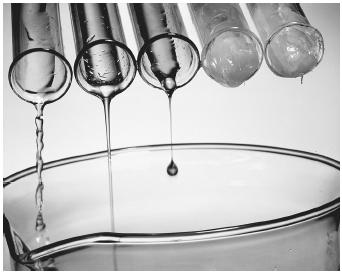crystalline vs amorphous solids
In single crystal silicon, the crystalline framework is homogenous, which can be recognized by an even external colouring. In single crystal silicon, also called monocrystal, the crystal lattice of the entire sample is continuous and unbroken with no grain boundaries. Large single crystals are exceedingly rare in nature and can also be difficult to produce in the laboratory (see also recrystallisation). In contrast, in an amorphous structure the order in atomic positions is limited to short range.

Crystalline Solids
Polycrystalline and paracrystalline phases (see Polycrystal) are composed of a number of smaller crystals or crystallites. Polycrystalline silicon (or semicrystalline silicon, polysilicon, poly-Si, or simply "poly") is a material consisting of multiple small silicon crystals. Polycrystalline cells can be recognized by a visible grain, a "metal flake effect". Semiconductor grade (also solar grade) polycrystalline silicon is converted to "single crystal" silicon – meaning that the randomly associated crystallites of silicon in "polycrystalline silicon" are converted to a large "single" crystal. Single crystal silicon is used to manufacture most Si-based microelectronic devices. Polycrystalline silicon can be as much as 99.9999% pure. Ultra-pure poly is used in the semiconductor industry, starting from poly rods that are five to eight feet in length. In microelectronic industry (semiconductor industry), poly is used both at the macro-scale and micro-scale (component) level. Single crystals are grown using the Czochralski process, float-zone and Bridgman techniques.

9/7 Crystalline vs. Amorphous
Polysilicon is a key component for integrated circuit and central processing unit manufacturers such as AMD and Intel. At the component level, polysilicon has long been used as the conducting gate material in MOSFET and CMOS processing technologies. For these technologies it is deposited using low-pressure chemical-vapour deposition (LPCVD) reactors at high temperatures and is usually heavily doped n-type or p-type.

OUTLINE Solids, liquids, and gases Crystalline vs. amorphous solids

Figure 9: Monte Carlo (solid

crystalline vs amorphous

Crystalline Vs Amorphous

Crystalline Solids
Polycrystalline and paracrystalline phases (see Polycrystal) are composed of a number of smaller crystals or crystallites. Polycrystalline silicon (or semicrystalline silicon, polysilicon, poly-Si, or simply "poly") is a material consisting of multiple small silicon crystals. Polycrystalline cells can be recognized by a visible grain, a "metal flake effect". Semiconductor grade (also solar grade) polycrystalline silicon is converted to "single crystal" silicon – meaning that the randomly associated crystallites of silicon in "polycrystalline silicon" are converted to a large "single" crystal. Single crystal silicon is used to manufacture most Si-based microelectronic devices. Polycrystalline silicon can be as much as 99.9999% pure. Ultra-pure poly is used in the semiconductor industry, starting from poly rods that are five to eight feet in length. In microelectronic industry (semiconductor industry), poly is used both at the macro-scale and micro-scale (component) level. Single crystals are grown using the Czochralski process, float-zone and Bridgman techniques.

9/7 Crystalline vs. Amorphous
Polysilicon is a key component for integrated circuit and central processing unit manufacturers such as AMD and Intel. At the component level, polysilicon has long been used as the conducting gate material in MOSFET and CMOS processing technologies. For these technologies it is deposited using low-pressure chemical-vapour deposition (LPCVD) reactors at high temperatures and is usually heavily doped n-type or p-type.

OUTLINE Solids, liquids, and gases Crystalline vs. amorphous solids

Figure 9: Monte Carlo (solid
crystalline vs amorphous

Crystalline Vs Amorphous

0 Comments:
Post a Comment
Subscribe to Post Comments [Atom]
<< Home